You're about to visit our French site (p2c.com/etudiants). This is a separate website with content created by our French-speaking team. Click "Continue" to proceed or "Stay Here" to remain on the English site.
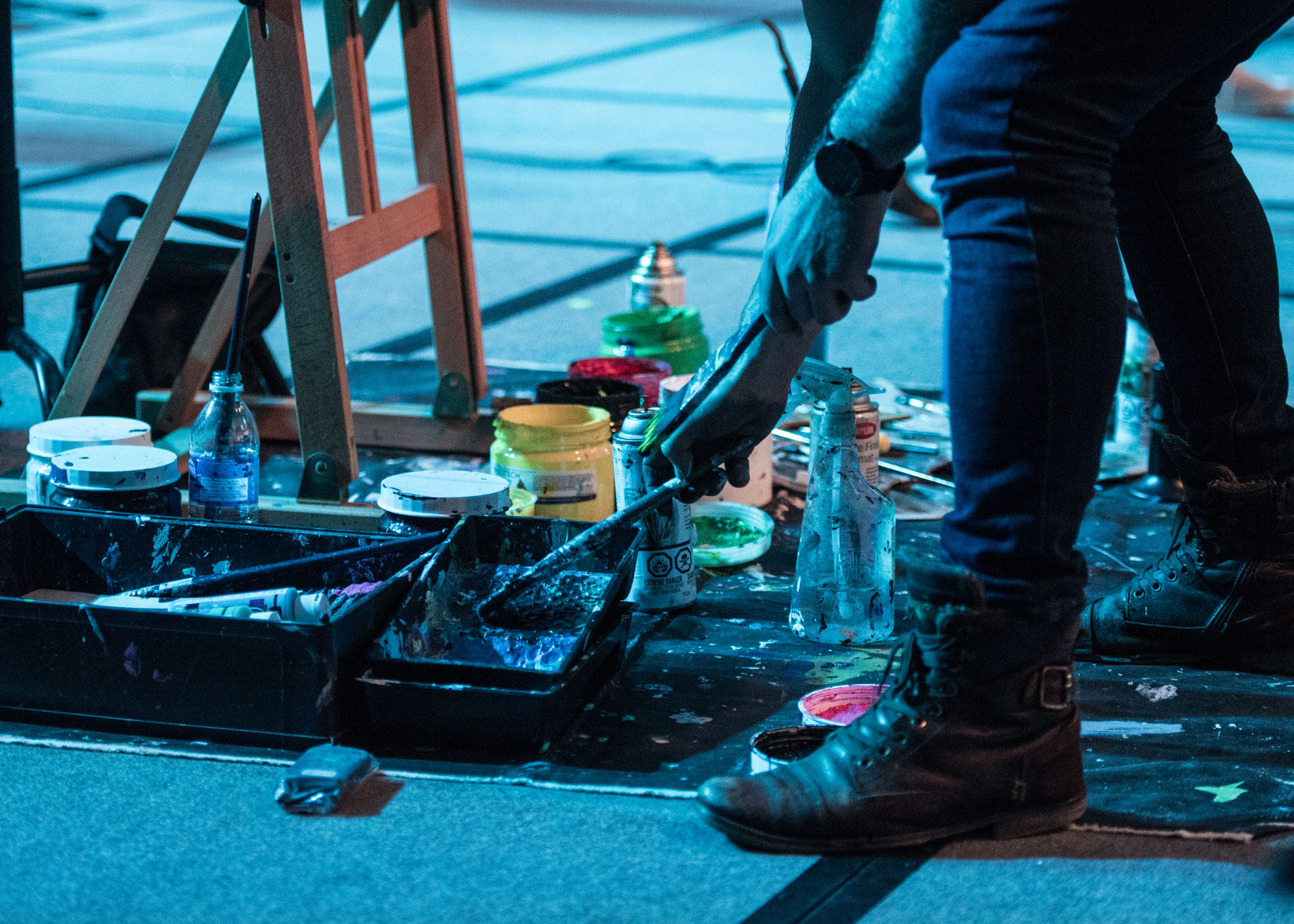
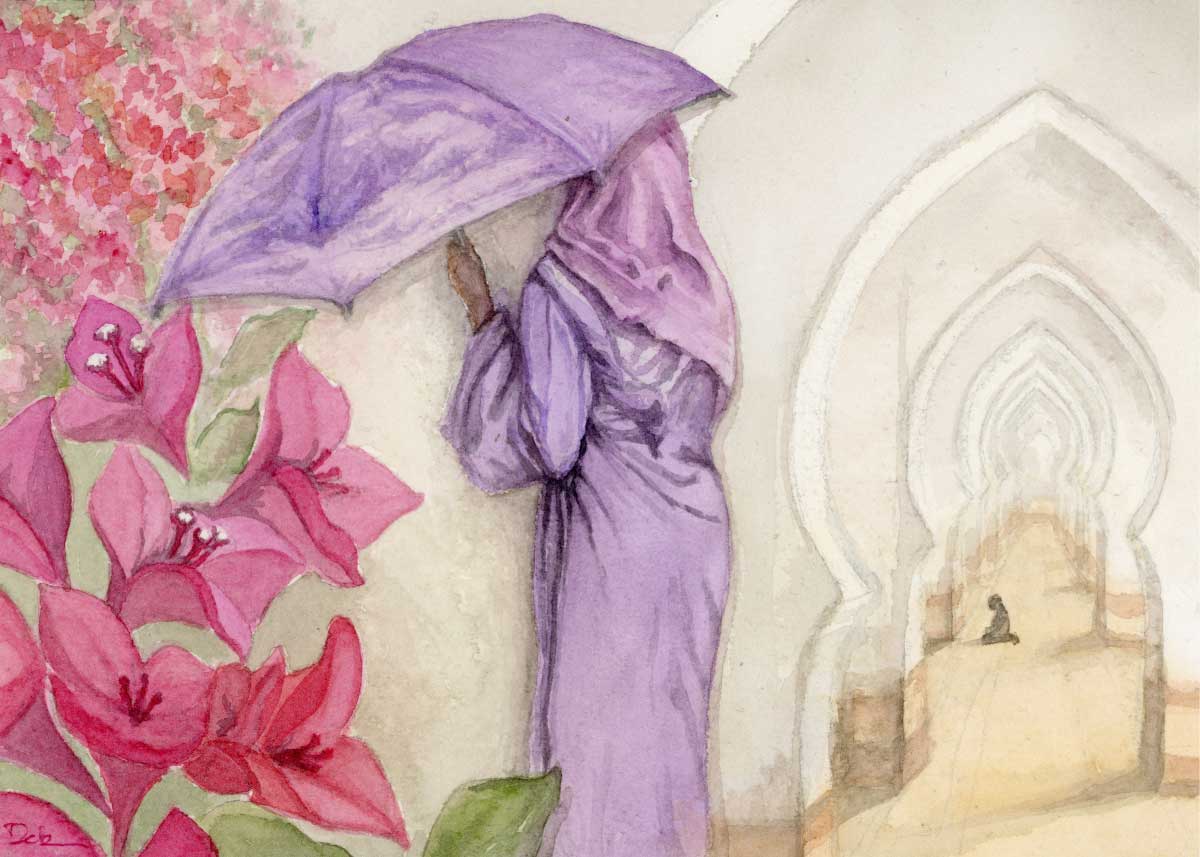
I watched as a man knelt in his place of worship. The filtered sun from the large entrance lit his back. Large arches stretched deep into the hall. It wasn’t the time for prayer, but he was there. I wondered about what he was seeking.
Vibrant blooms of orange, pink, and purple spilled over fences and walls along the streets. These flowers are able to flourish in drought-like conditions because its roots reach deep into the soil for water.
A woman stood in the market on a rainy day. I stood across the alley from her. Her choices of lavender and pink stood out amongst the greyish browns that trickled down from the awnings above, forming puddles at our feet. I took her photograph. I didn’t know her story.

As a photographer, I often make photographs not knowing what meaning or purpose they might have in the future. Be present. Pay attention. Be curious. These three moments stood out from my collection of photographs as I was researching for this painting. A man praying. Flowers in full bloom. A woman in purple sheltering from the rain.

Together, these three snapshots echo the prayer of Isaiah: “I am doing a new thing; now it springs forth, do you not perceive it? I will make a way in the wilderness and rivers in the desert.” May God’s grace rain down and form rivers in the desert.
This is the prayer I held as I put my watercolours to paper, for God to pour out his life-giving Spirit, and may he renew all people and things to himself.

I chose this colour palette and the medium of watercolours to reflect the warmth and softness of the people marked by generosity and welcome. I recessed the praying scene so it would form as the backdrop, choosing to draw the woman with the umbrella and the flowers in full bloom forward, describing what God is doing, bringing life in places where people are seeking.

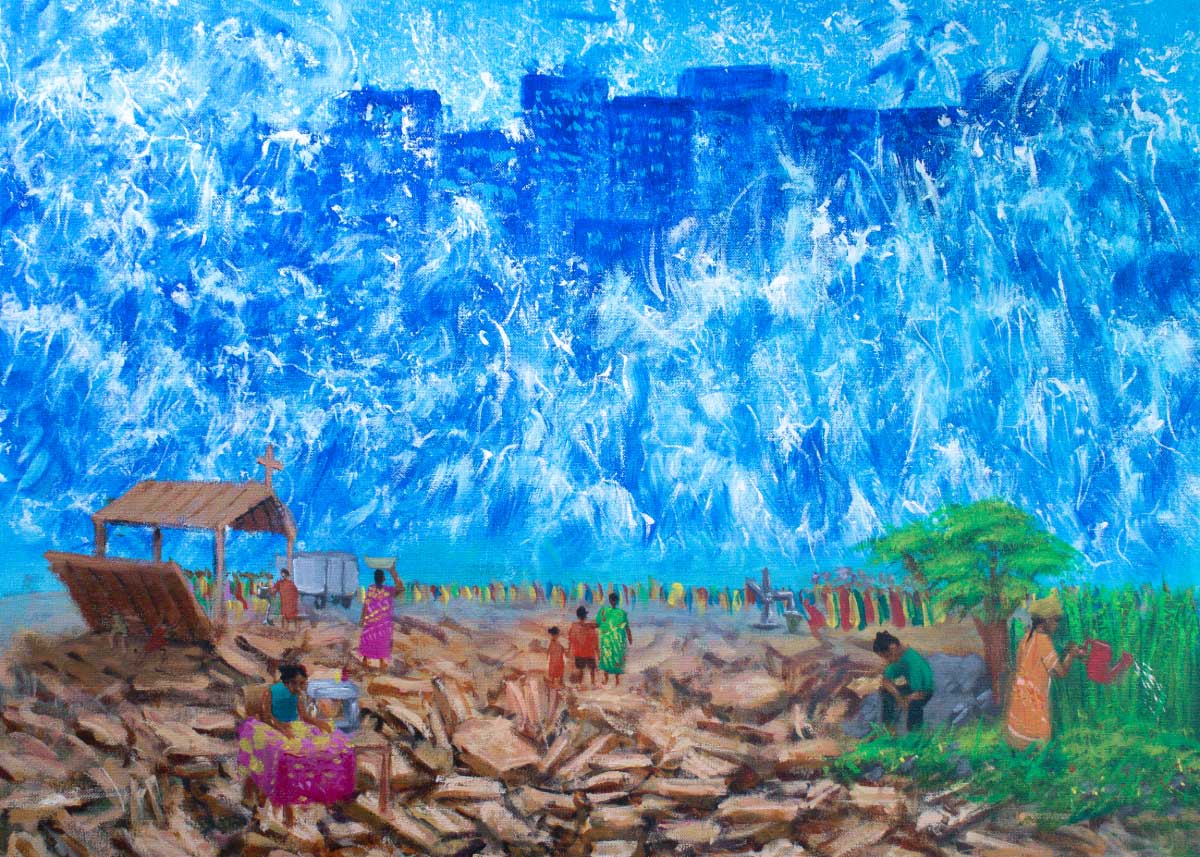
The blue waves forming the background of the painting represent the great waters of the world’s oceans. The downtown city landscape has people coming out of the city, representing those who faithfully respond to the Holy Spirit to offer compassionate help to vulnerable populations in other places of the world. This action of coming out of the water also symbolizes baptism. Those who respond to the call of Jesus are stepping out in great faith and trust in his redemptive work for the peoples all around the earth, for whom he cares deeply about.
The ocean is representative of many things. The wall of water is a call back to God’s miraculous act of splitting the Red Sea in the book of Exodus. Additionally, water often symbolizes chaos and death, a reality that many people face daily when battling issues of water insecurity, natural disasters, and generational poverty. Lastly, the water displays our distance from one another around the globe. Yet people who are oceans apart can come together from great distances.
Regarding the process of painting this piece, I focused my energy and time expressing the roaring of the seas for it to be worthy of what it represents: the grand, majestic, and awesomely terrifying power of water. I used crumbled paper and random flicks of an old bristle brush to bring out the unpredictability and random nature of the waves.
Ironically, I didn't have the same chaotic mindset when painting the rubble of demolished buildings; I held on to my tiny brush with more precision. Water and rubble, blues and browns, take over the painting, two-thirds blue and one-third brown. This was purposeful to follow the rule of thirds (a compositional technique) and creates the foundation for the people in the painting to stand out. They may be small, but different enough for you to see the life that is in them.
Look closely at the scenes in the foreground of the painting. They showcase GAiN’s four different areas of focus:
the Water for Life initiative
disaster relief and preparedness
economic empowerment
local church partnerships
.jpg)
「我願為祢去」or「我愿为祢去」illustrated in this postcard translates to “God, I’m willing to go for you.” Going on a mission trip for the first time felt very daunting. I had many doubts prior to the trip: What if my Mandarin is bad? What if I don’t have the confidence to evangelize? Looking back, I realized these were Satan’s attacks and lies.
During the two weeks our team spent in Germany, we visited local universities to share God’s love with Chinese international students and our stories of how Jesus transformed our lives. Even though there were many fears and uncertainties in the beginning, God continued to remind us that missions is a partnership with the Holy Spirit and not based on our own strength. Everything we did as a team—campus evangelism, planning events, and personal conversations with the new students we met—was a testament to God’s power and sovereignty.
Jesus said, “Abide in me, and I in you. As the branch cannot bear fruit by itself, unless it abides in the vine, neither can you, unless you abide in me.” (John 15:4). Remembering that I am a vessel that God can always use, regardless of my weaknesses, is a big takeaway from this trip. The phrase「我願為祢去」is an encouragement to students to do God’s work and also allow him to work in you, whether on missions, in your current city, or abroad.

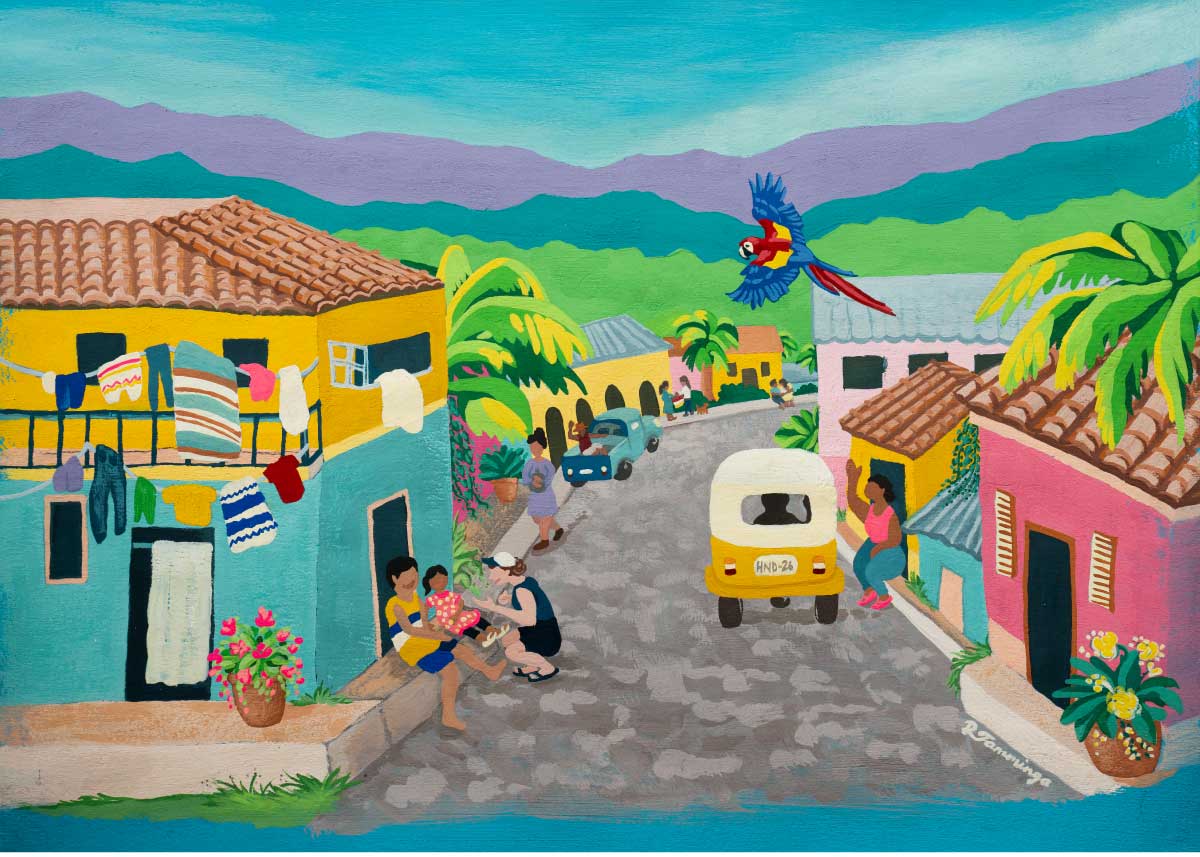
Honduras shouts to me of vibrance, warmth, and friendliness. I sought to draw out these qualities in my painting. I chose gouache as the painting medium because of its bold, bright colours and its ability to be both transparent and opaque. This helped to create the vibrant colours and atmosphere of the scene.
I love the warmth and friendliness of the Honduran people, and I referenced photos from last year’s Honduras mission trip to create realistic moments which would display this warmth, and welcome viewers into the scene.

I drew the initial sketch freehand on a digital drawing tablet and painted a teal base coat on my art paper. I printed the background layer of my sketch to scale and traced it onto my teal base using carbon paper so I could paint the background elements. Then I repeated the tracing process with the detailed elements, tracing and then painting the people, vehicles, laundry, trees, plants, and macaw.

Some significant elements in the painting are the scarlet macaw (Honduras’ national bird), the dark blue and white blanket (Honduras’ flag colours and cultural dress style), and the license plate on the mototaxi (“HND-26”, meaning “Honduras, 2026”). The woman speaking with the children on the apartment step was referenced from an actual photo from the 2025 Honduras mission trip. This scene highlights that ministry to children is a significant part of the trip.

I defined shapes with colour and shading rather than outlines to create natural three dimensional space. This style, especially with bright and vibrant colours, is common in artwork from Latin America, and I wanted to try it for myself. It’s a very different art style than I typically work in, and it was my first full painting using gouache, so this project was a satisfying challenge.

The final image is bold, warm, and vibrant, and I find it inviting and welcoming. The friendly people make me smile, and I wish I could step right into the scene. Creating this artwork for the Honduras mission trip was fun and stretching for me, and I’m so grateful I could use my art to invite others to share the love of Christ in Honduras.

.jpg)
The isometric concept of this postcard seeks to highlight the multi-faceted nature of this mission trip, integrating a breadth of operational skills and giftings into a cohesive image.
In the process of designing this image, I decided it was crucial to feature people in action, collaborating and working together on various projects. Rather than creating an image composed solely of symbols (such as mouse arrows, heart emojis, and other icons that harken to industries such as communications, social media, or technology), I wanted the image to portray individuals in action.

I kept the colour choices bright to emphasize the amount of creativity that is welcome and invited into the I-GO space—creativity in daily innovation, problem-solving, design, teamwork, and more. The cubic structure unifies multiple scenes of the different settings that participants of I-GO may find themselves in. It emphasizes both the diversity as well as the unity of all these skill sets in kingdom work.

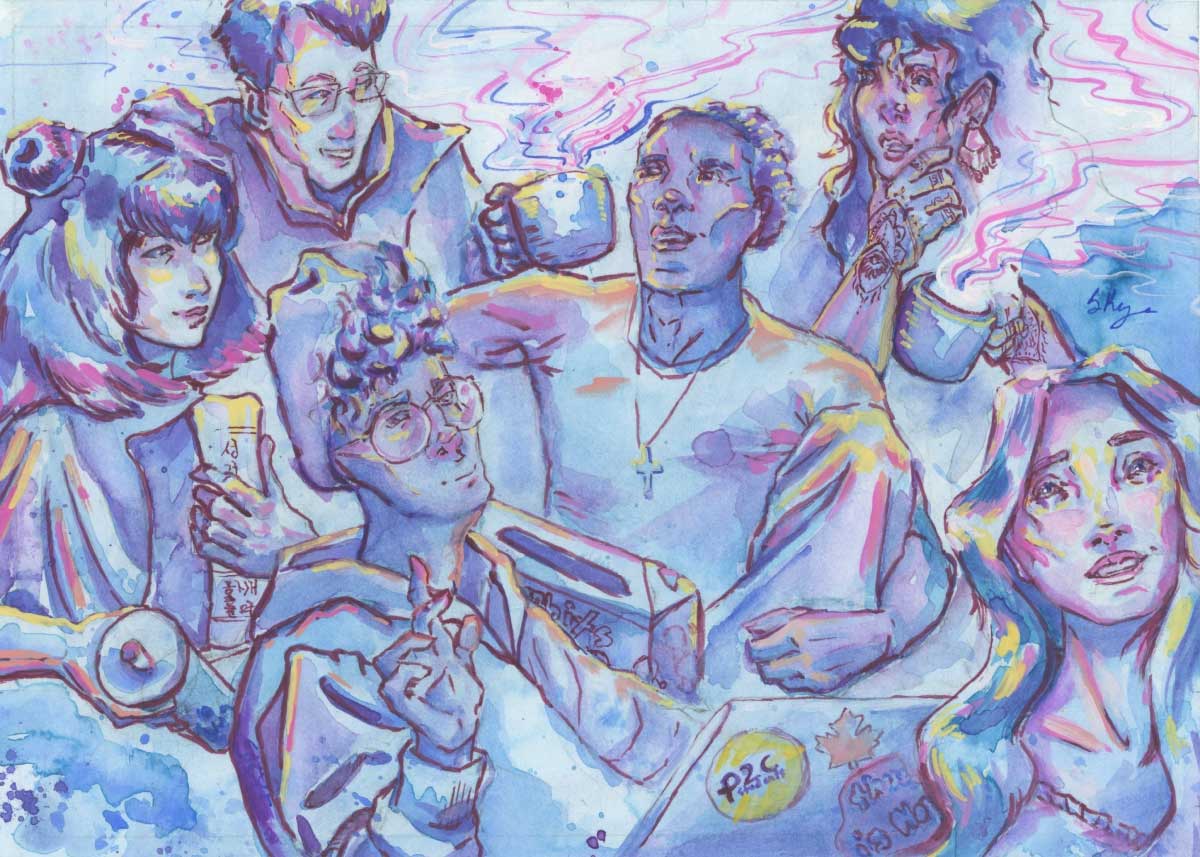
As a Canadian student who was a part of P2C, I really appreciated my international friends, and this painting was inspired by my favourite memories of us hanging out. This painting captures a moment of these memories: a group with a diverse set of experiences coming together to build a common community. A variety of food and drinks are present, while a few people talk theology, some do homework, and others chat—probably about fun upcoming P2C events!
I was thankful for friends who asked deep questions and helped me consider new perspectives. Especially when we hung out in a big group, it usually wasn't long before conversations turned theological. Everyone not only brought different questions—based on their experiences or cultural context—but also different ways of thinking to answer those questions.

I included only a minimal background because when we would hang out, it was the people that mattered, not the place. Tiny apartment living rooms smell pretty good when everyone is holding a steamy cup of chai! Food was an invitation to culture that I received from friends, and got to offer in return (recommending a flavour for someone’s first Tim’s donut is a lot of pressure!). My friends greatly encouraged my bubble tea habit, and so the painting had to include our favourite, colourful drink! I loved getting to include little cultural details, such as a Korean Bible. I am a long-time admirer of henna, and had to sneak that in, too!

I chose the medium of watercolours and gouache because I love how they allow me to create a cozy, relaxed atmosphere without sacrificing my ability to tighten up the details. I hope this painting inspires possibilities for the community that can be created when we take steps to get to know one another.

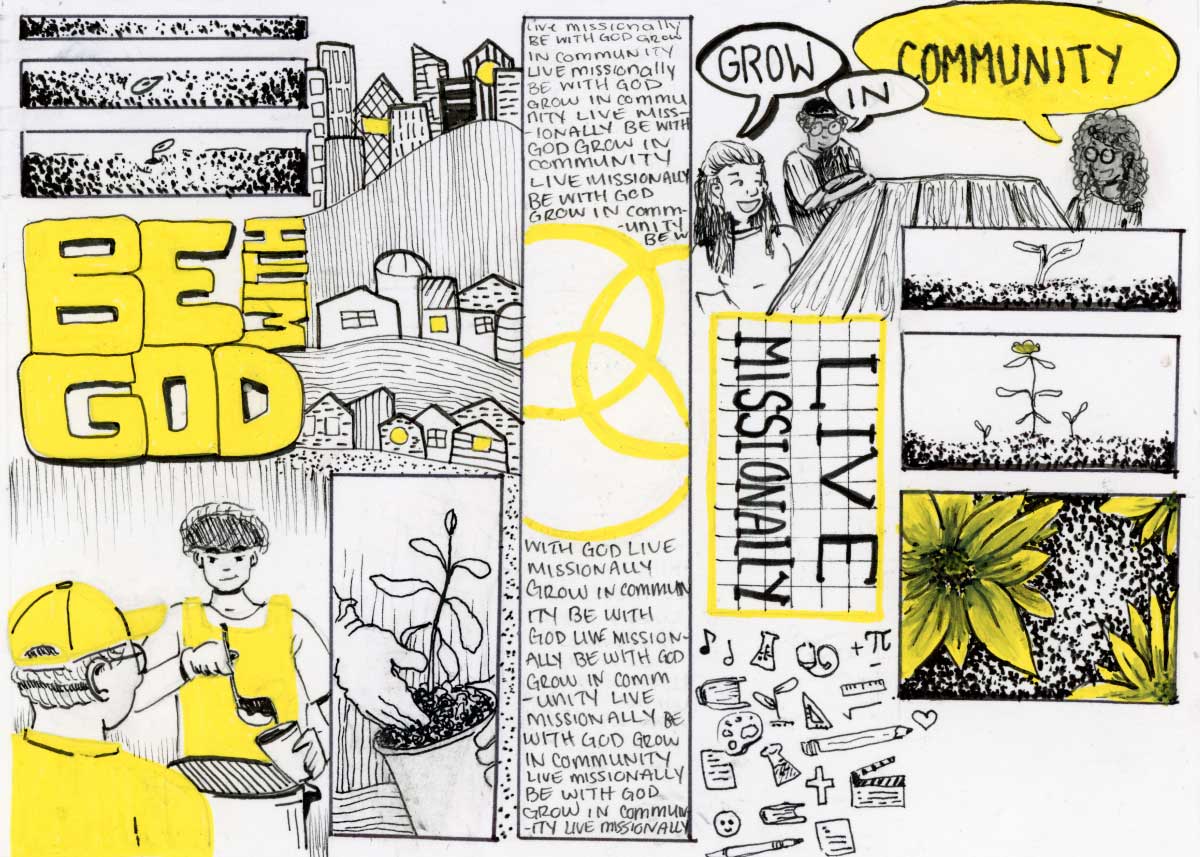
PRAXIS is the exploration of missional living—putting your faith into practice—in all of life. The invitation of the artwork is to see the renewal of that gospel anywhere and everywhere. PRAXIS is not tied to a particular location or type of work, so I wanted the piece to live in the liminal space of tangible actions and abstract concepts.
I drew on my own experience of participating in the PRAXIS 2024 trip to root the artwork in distinct visuals of the PRAXIS core values:
Be with God
Live missionally
Grow in community
Experiences such as serving people experiencing homelessness, planting a garden, and enjoying a conversation visually represent these values.
The challenge comes when considering how to create a visual piece that balances concrete and abstract. Especially in a small artwork like this, visuals have to carry weight without taking up much space. So how do you concretely—and simply—represent concepts of renewal, growth, rest, empathy, and missionality? To further the challenge, how does one concretely do this without misrepresenting the beautiful reality that PRAXIS is intrinsically liminal? I'm not sure this can be achieved, however there are some aspects to the piece that point toward balance.
The style of the artwork follows this desire to represent this space between concrete and abstract, the miraculous and mundane. The contrast of a bold yellow against the fine, black linework draws the eye towards the colourful spaces. Similarly, when we allow our eyes to be opened to the renewing work of the gospel, we can't help but see God at work around us.

Little vignettes distinguish the scenes of life from the abstract representations of growth and renewal. This isn't necessarily to separate these moments, but rather to show again the relationship of the two: as we live on mission, seeking to be with God and in community, we often have distinct moments of recognizing God. In this, too, is the differentiation in visual styles: curved organic shapes (humans, nature) intertwined with rigid, angular shapes (boxes, buildings, lines of text).

Finally, the artwork has a similar visual style to a comic book or graphic novel. My hope is that the piece would evoke these mediums to root the artwork in story. The telling and receiving of stories is something that I deeply value as an artist and a person. And as a PRAXIS participant, "story" was a medium that God used to draw me closer to others and himself. Just as with a comic or graphic novel, my intention is that this collection of images would point towards a greater story being authored together.

.jpg)
Global Missions Vietnam focuses on ministering to local university students and building meaningful relationships through daily life. The Beach was a new city for these teams, which meant pioneering connections, building trust, and stepping into unfamiliar spaces with faith and humility. The students partnered with local Christian student leaders and churches, invested in friendships, and created spaces where honest conversations about Jesus could unfold naturally.
I took inspiration from the photos and videos shared by the 2024 and 2025 Global Missions Vietnam team. I hoped to capture the vibrant sights and tastes of the Beach, from its pristine beaches and palm-lined streets to its family-run street food stalls, cafés, and bustling city life.

More importantly, I wanted to reflect the sense of togetherness and the shared experience of Jesus’ love that shaped this trip. One student shared that what stood out wasn’t just the scenery or food, but also the long conversations with Vietnamese friends, the glimpses into their lives, and learning to love and serve their team well.

To hold all of this in a postcard, I chose a travel sketchbook style of ink linework and alcohol markers arranged as collage blocks rather than a single image. I selected scenes that showed the city’s unique offerings alongside the joys of living on mission together. Each sketch was drawn, copied, and coloured, then pieced together digitally with a soft background colour wash.

My hope is that you will sense the warmth of those friendships and the fullness of sharing life and faith across cultures. May it invite you to notice the simple but meaningful ways God works through shared meals, unhurried conversations, and laughter shared among believers.
